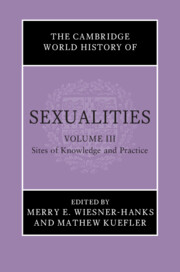959 results
Chapter 9 - Intra- and Intergenerational Justice, Law, and DOHaD
- from Section 2 - The Social Life of DOHaD
-
-
- Book:
- The Handbook of DOHaD and Society
- Print publication:
- 27 June 2024, pp 117-130
-
- Chapter
-
- You have access
- Open access
- HTML
- Export citation
Chapter 26 - The Promise of Reversibility in Neuroepigenetics Research on Traumatic Memories
- from Section 6 - Future Directions
-
-
- Book:
- The Handbook of DOHaD and Society
- Print publication:
- 27 June 2024, pp 290-299
-
- Chapter
-
- You have access
- Open access
- HTML
- Export citation
4 - Who Constitutes Power?
-
- Book:
- Radically Legal
- Print publication:
- 06 June 2024, pp 71-102
-
- Chapter
-
- You have access
- Open access
- HTML
- Export citation
Adultery Law and State Power in Early Empires: China and Rome Compared
-
- Journal:
- Asian Journal of Law and Society , First View
- Published online by Cambridge University Press:
- 03 June 2024, pp. 1-21
-
- Article
- Export citation
2 - Law as Text
-
-
- Book:
- The Cambridge Comparative History of Ancient Law
- Published online:
- 09 May 2024
- Print publication:
- 30 May 2024, pp 20-72
-
- Chapter
- Export citation
11 - Sex in Geneva in the Sixteenth Century
-
-
- Book:
- The Cambridge World History of Sexualities
- Published online:
- 26 April 2024
- Print publication:
- 16 May 2024, pp 210-231
-
- Chapter
- Export citation
5 - Sexuality in Baghdad in the Ninth and Tenth Centuries ce
-
-
- Book:
- The Cambridge World History of Sexualities
- Published online:
- 26 April 2024
- Print publication:
- 16 May 2024, pp 87-107
-
- Chapter
- Export citation
12 - Sexuality in Jewish Traditions
-
-
- Book:
- The Cambridge World History of Sexualities
- Published online:
- 26 April 2024
- Print publication:
- 16 May 2024, pp 250-270
-
- Chapter
- Export citation
10 - Sex in Sixteenth-Century Istanbul
-
-
- Book:
- The Cambridge World History of Sexualities
- Published online:
- 26 April 2024
- Print publication:
- 16 May 2024, pp 191-209
-
- Chapter
- Export citation
3 - Sex in Constantinople in the Sixth Century ce
-
-
- Book:
- The Cambridge World History of Sexualities
- Published online:
- 26 April 2024
- Print publication:
- 16 May 2024, pp 47-66
-
- Chapter
- Export citation
Sweatshops and Labour Law: The Ethical and Legal Implications of Ignoring Labour Law in Developing Countries
-
- Journal:
- Business and Human Rights Journal , First View
- Published online by Cambridge University Press:
- 09 May 2024, pp. 1-20
-
- Article
-
- You have access
- Open access
- HTML
- Export citation
3 - Bending the Law
- from Part III - The Emergence of Lawfare
-
- Book:
- The Violence of Law
- Published online:
- 30 April 2024
- Print publication:
- 02 May 2024, pp 91-141
-
- Chapter
- Export citation
1 - Sea Power and Strategy
- from Part I - Sea Power and Its Relationship to Strategy and Law
-
- Book:
- Balancing Strategy
- Published online:
- 25 April 2024
- Print publication:
- 02 May 2024, pp 23-38
-
- Chapter
- Export citation
2 - Law and Sea Power
- from Part I - Sea Power and Its Relationship to Strategy and Law
-
- Book:
- Balancing Strategy
- Published online:
- 25 April 2024
- Print publication:
- 02 May 2024, pp 39-52
-
- Chapter
- Export citation

The Cambridge World History of Sexualities
-
- Published online:
- 26 April 2024
- Print publication:
- 16 May 2024
The Legality and Ethics of Web Scraping in Archaeology
-
- Journal:
- Advances in Archaeological Practice , First View
- Published online by Cambridge University Press:
- 19 April 2024, pp. 1-9
-
- Article
-
- You have access
- Open access
- HTML
- Export citation
Should Catholics Support Laws Prohibiting Abortion?
-
- Journal:
- New Blackfriars / Volume 105 / Issue 3 / May 2024
- Published online by Cambridge University Press:
- 18 April 2024, pp. 244-264
- Print publication:
- May 2024
-
- Article
-
- You have access
- Open access
- HTML
- Export citation
1 - Introduction
-
- Book:
- Brotherhood of Barristers
- Published online:
- 11 April 2024
- Print publication:
- 18 April 2024, pp 1-18
-
- Chapter
- Export citation
Chapter 3 - Oratorical Ambiguity
-
- Book:
- Freedom and Power in Classical Athens
- Published online:
- 04 April 2024
- Print publication:
- 11 April 2024, pp 56-87
-
- Chapter
- Export citation

Brotherhood of Barristers
- A Cultural History of the British Legal Profession, 1840–1940
-
- Published online:
- 11 April 2024
- Print publication:
- 18 April 2024



